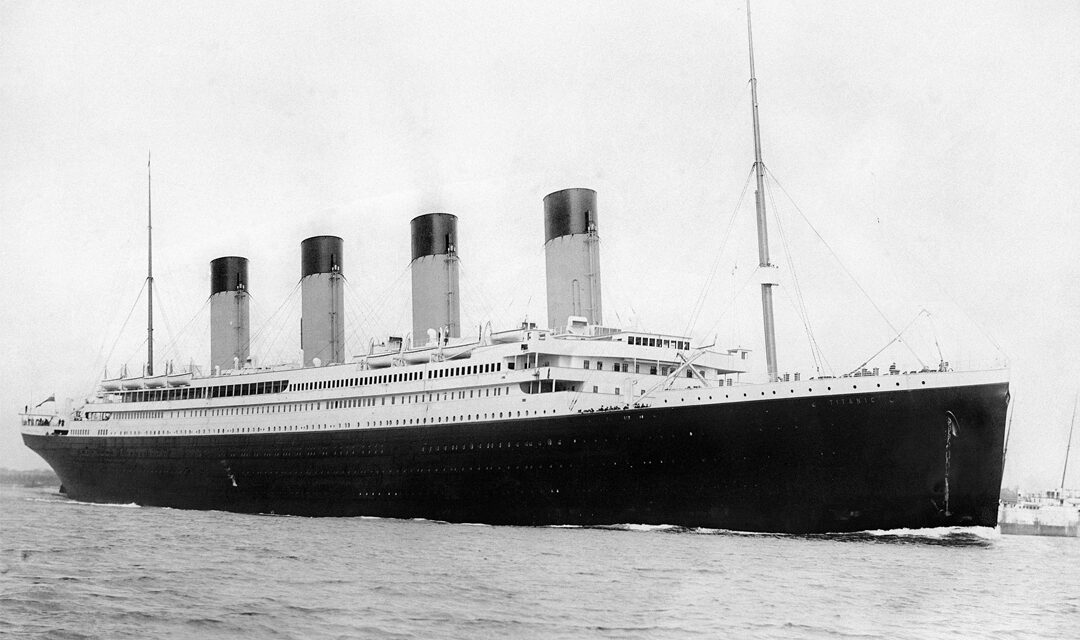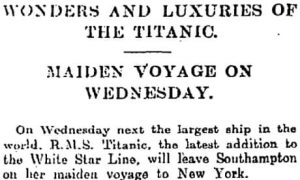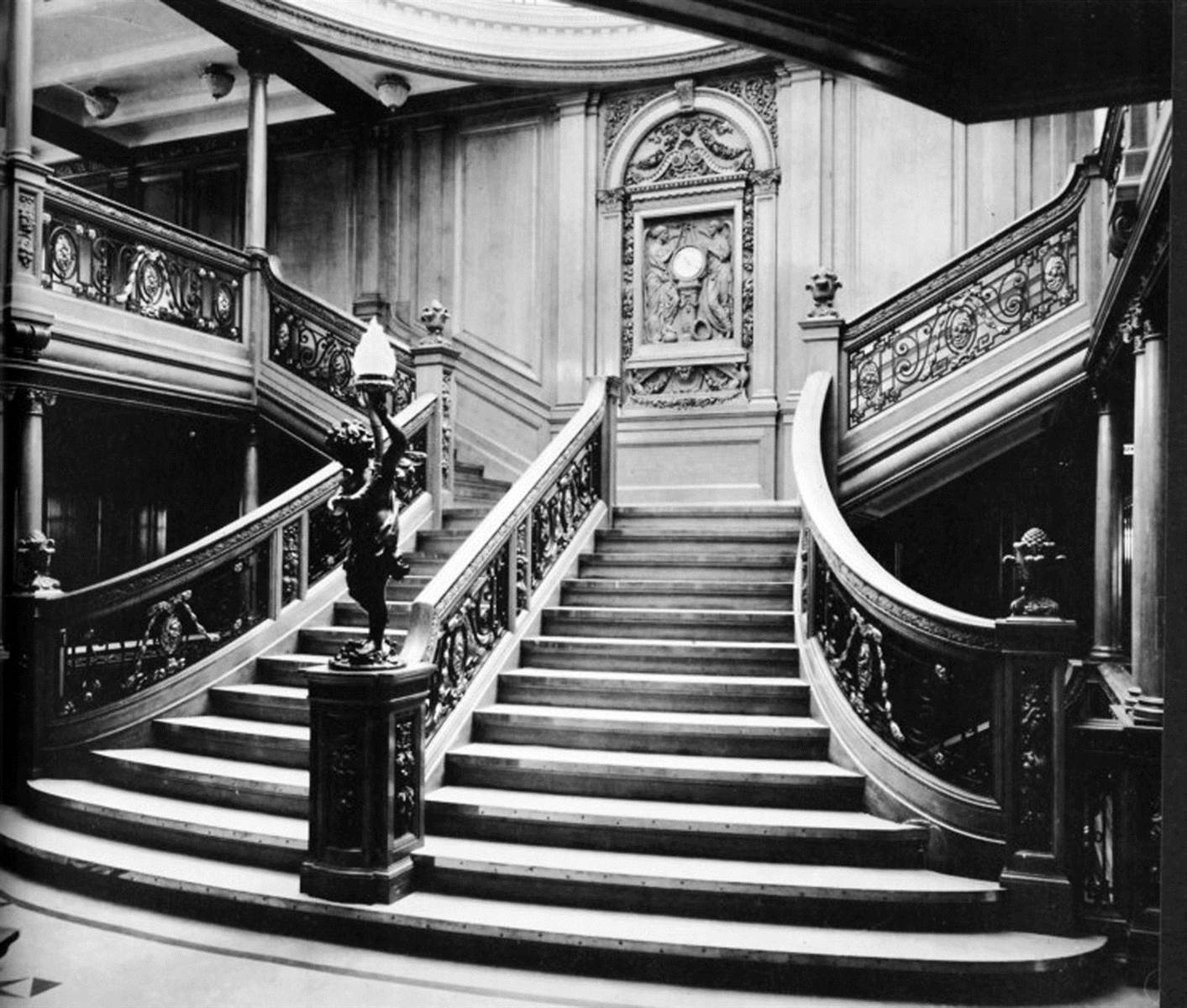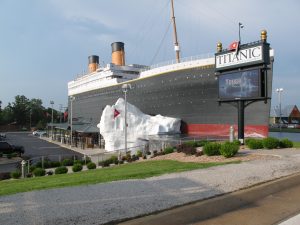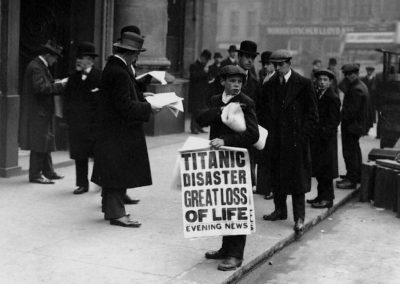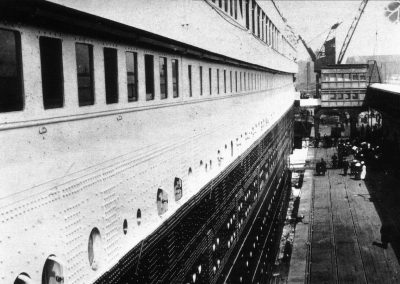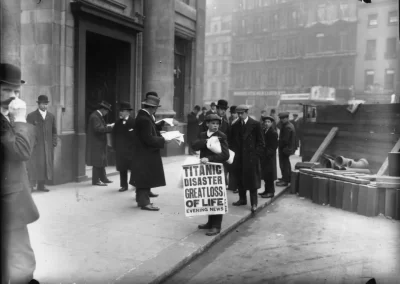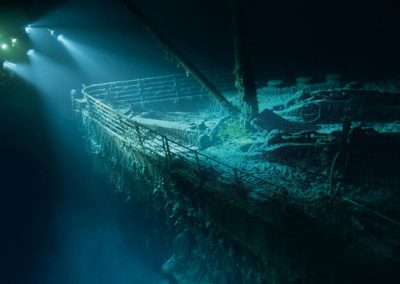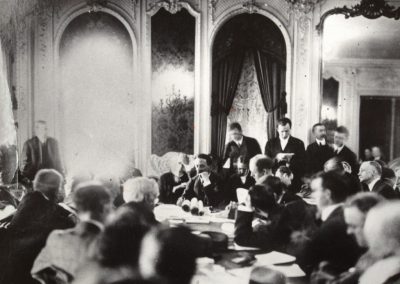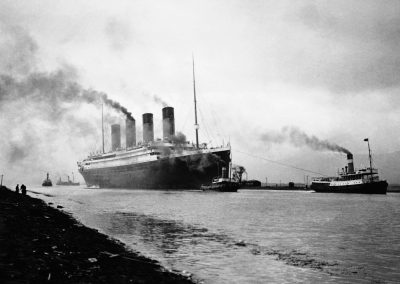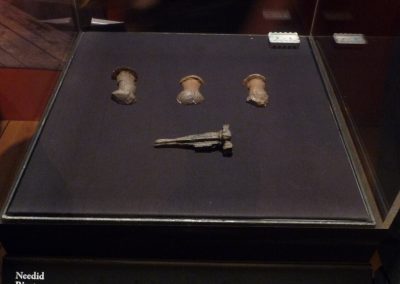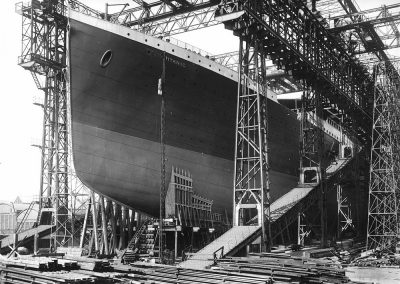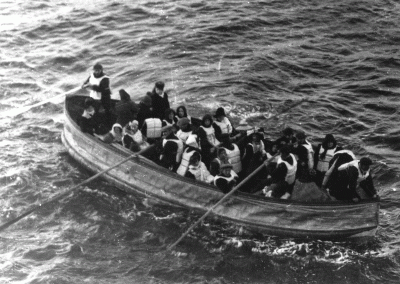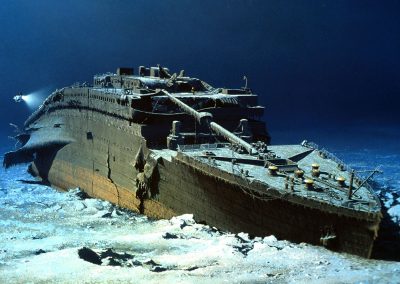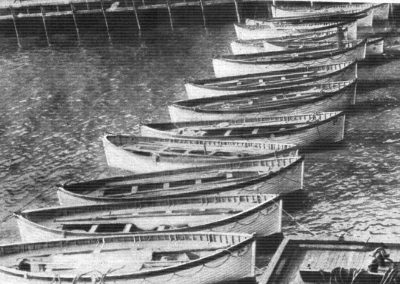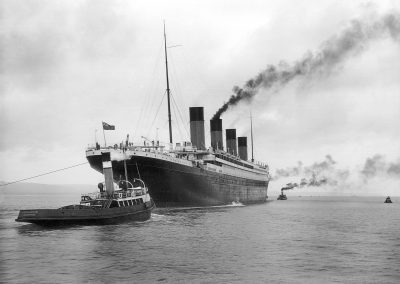RMS Titanic
The demise of the Titanic could easily be a Social and Psychological Mystery, for all the power it’s had on our popular imagination and psyche. But we list it here as a Scientific Mystery, ongoing, with new evidence or at least new theories about old evidence still surfacing.
Over 1,500 people lost their lives the night of April 15, 1912. Are we sure, even now, what led to the collision, and what sunk an ‘unsinkable’ boat? Will the books ever really be closed on the mysteries of the Titanic?
The RMS Titanic
The RMS Titanic took to the seas as a source of wonder, an almost indescribable engineering feat, and statement of incredible luxury. Remember, passenger service across The Atlantic by air lay decades into the future. And now, early in the 20th century, came the great steam ships, with double magic–they were extremely fast, and extremely luxurious.
The highest level of opulence of course was limited to first-class passengers, but it was unprecedented.
“Two extraordinary first-class suites were constructed on B deck, one of them earmarked for J.P. Morgan. In addition to sumptuous state-room accommodations, these suites featured a spacious parlor and a promenade deck with half-timbered walls of the Elizabethan period; at the height of the season, the suites went for $4,350 one way (well over a hundred thousand in today’s money). On the same deck, a Parisian boulevard was added to the restaurant, giving the satisfying illusion of a French side-walk café.”
From: “The Titanic: End of a Dream” by Wyn Craig Wade
Truly it’s almost impossible, impossible to recreate the setting, the feeling of the times in which the first luxurious cities on water crossed the ocean. After all, that was then, and this is now, a very blasé time, when even the “incredible” almost bores us.
But it may have been the most incredible of all “thens,” back then, just a few decades into the scientific and industrial revolutions. It’s hard now to imagine growing up in towns in Europe, or the U.S., connected by slow horses and buggies to the next small town, but a decade or two later going to sleep on a train and waking up hundreds of miles away. And the same lad who rode the striking trajectory of the railroads, the electric light, the emerging automobile, could now contemplate crossing the ocean quickly and safely. Great new steamships, longer and taller than the eye could quite believe, made the slow and risky crossing by sailing ship seem like a thing of the past.
For a long time those with the need or the means to cross the Atlantic had often still hesitated to do so. As the English wit Samuel Johnson had said, the time crammed onto a ship’s hold crossing the sea was a bit like going to prison, but “with a chance to be drowned.” But that was all changing quickly in the first two decades of the twentieth century. The huge steamships were fast, so much bigger it seemed than waves and storms, and full of luxury. The week to ten days that a trip from Dublin to New York would take was barely enough time to sample all the restaurants in your floating hotel, to walk the promenades at all times of day and evening, to browse in the multiple libraries that the ship offered, or relax in the game rooms. Before you could be bored, you’d be on a new continent.
The Titanic, when it sailed on April 10, 1912, boasted a crew and staff of over 900, an army of employees, enough to staff one of the largest cities of the era. The scale of the ship echoed the scale of human aspiration in the new age. Anything was possible, limits were melting away when touched by the magic wand of science and industry.
The Titanic, one of the largest structures that man had ever built, could carry over 3,500 people. At 880 feet long and over 100 feet high, she was marketed by the owners as a super ship, a miracle of modern engineering. Dubbed by a Belfast Newspaper as “unsinkable,” Titanic was almost an Eighth Wonder of The World. First class passengers were wowed with mahogany lined rooms while steerage class passengers had dreams of new lives in America. Why wouldn’t you want to sail on something like that?
An Iceberg and Horror
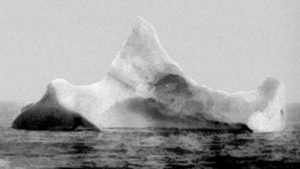 No question about it, the Titanic was making good time, and for the Captain and White Star Line, that was the point.
No question about it, the Titanic was making good time, and for the Captain and White Star Line, that was the point.
Enormous investor capital had been mustered to build the new colossal steamships, lots more was spent to operate them, but in the end the hope was that the combination of luxury and speed would prove irresistible to intercontinental travelers. That would allow fully booked ships, at premier prices, to turn a steady profit.
Thus when captain Edward J. Smith was informed that his path across the North Atlantic was laden with icebergs, part of his calculus was the high cost of delay. Captains of some ships had chosen the steam-by-day, anchor-by-night approach, so pronounced was the ice hazard, but that wasn’t part of the Titanic’s business plan.
Apparently Captain Smith had asserted: I cannot imagine any condition which would cause this ship to founder, I cannot conceive of any vital disaster happening to this vessel.
The ship’s navel architect, Thomas Andrews, and modern shipbuilders essentially echoed this attitude and were confirmed in their thinking because there’d been no recent incidents involving a large passenger vessel resulting in serious loss of life and it wasn’t going to happen to them.
Thomas Andrew was so confident in the Titanic’s design that he assured passengers the internal structure would hold under any circumstances and would keep the water at bay. He essentially guaranteed that the Titanic could not sink.
The floating community of the ship had been lulled into a false sense of security.
The ship was so stable after the initial iceberg hit, many people refused to board the lifeboats. The combined tragedy of not having enough lifeboats (due partly to assurance that the ship was unsinkable) and the over confidence of the passengers, led to some lifeboats launched with very few people in them.
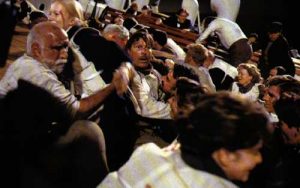
It wasn’t until near the end, when it was painfully obvious that there were not enough lifeboats and the ship was indeed sinking that the passengers panicked.
So, The Titanic was supposedly built to survive a disaster like a collision at sea. At first, after the iceberg strike, it looked like she would stay afloat well into the next day. But just two hours later, the ship sank to the bottom of the sea. Plummeting two and a half miles into the deep, black freezing waters of the Atlantic. Leaving 1,500 souls to freeze to death in the frigid watery darkness of a chaotic night.
Life jackets on the Titanic were much more plentiful than seats on lifeboats. Water just above freezing temperatures shuts down a human’s vital functions within minutes. Thus, most victims didn’t drown, just froze to death.
Searching for Answers
The mundane mystery of the Titanic will always be: what really caused the disaster? Experienced seamen maintain that is was a plain case of negligent navigation, particularly on the part of Captain Edward J. Smith. It was E.J. who neglected to pay sufficient heed to numerous ice warnings, who neglected to reduce the speed of the ship, who neglected to post extra lookouts in the eyes of the ship, and who neglected to inform his officers of the gravity of the situation before they loaded the lifeboats.
“The Titanic: End of a Dream” by Wyn Craig Wade
Those may be the most basic facts, but the questions about the Titanic on its final and fatal journey are many.
The scientific Sherlock, and the Psychological and Historical detectives as well all have questions:
- What part did hubris play in the disaster, the feeling that a ship this large and powerful was almost invulnerable to nature?
- Did the recent history of steaming–with very few fatalities and few iceberg encounters–play a key role in that complacency? We tend to only believe in the type of accidents which have happened within recent memory.
- Was a substandard steel or riveting procedure used, one that made the ship more vulnerable than necessary? Metallurgists will go on about this topic at some length.
- Could another compartmentalizing process, in the design, have contained the interior flooding? The ship could have remained afloat indefinitely, or at least a lot longer, had the flooding been limited.
Titanic, Searching for Answers
Why was the Titanic going so fast when the warning came about the ice field in her path? Why did she not divert? Was the unsinkable theory just a marketing ploy? Was it even the Titanic that sank and not her sister ship the Olympic.
There are so many theories, some of them a bit far-fetched, but important to know.
Here are just a few.
Some people actually believe that it was in fact sister ship the Olympic that sank as part of an insurance scam. The reason behind people thinking that the ship is not Titanic takes us back to September 20th 1911 when the Olympic collided with the HMS Hawke just off the coast of the Isle of Wight. This incident caused many problems for the ship’s owners as this meant that it would have had to be taken out of service while they would be repairing it and that the maiden voyage of Titanic had to be put back from the 20th March to the 10th April. This at the time was something that White Star Line could not afford to do as they had legal bills to pay and the cost of repairing the Olympic, as well, this meant that they had to come up with a way to claim back not only the money that they would have missed due to Olympic not being in service, but also the money they couldn’t claim back from the incident. So they came up with a plan– simply switch Olympic with her sister ship Titanic and sink it to claim compensation. No one would know they had swapped the ships except the people in charge, such as J Bruce Ismay, Thomas Andrews and JP Morgan.
If you looked at the ships when they were standing beside each other you would not know which one was which unless you looked at the name plates on both ships. However there is one thing that allows people to tell the difference between the two ships and it is the portholes on the sea deck. When the Titanic was pictured while being built it had 14 evenly spaced portholes but when it left Southampton on it’s doomed maiden voyage on April 10th 1912 it had 16 unevenly spaced portholes, or so goes the allegation.
And a few questions that will be perennially discussed.
What was the mystery ship that so many claimed to see?
The mystery ship many people standing on the sloping decks of the Titanic looking around for anything that could help them. When they looked at the horizon they saw a light that could only come from another ship. Some survivors testified that it was the Californian that was ignoring their rockets. The officers that were on duty that night claimed that there was indeed another ship. Who was this mystery ship?
There are many theories about who this mystery ship was and a name much mentioned is The Sampson, a Norwegian sailing ship. Supposedly the Sampson was in the area hunting the seals that called the bigger icebergs their home. An activity is considered poaching and illegal.
When the Titanic started going down, the orders were given for rockets to be shot off to get the attention of the ship on the horizon. Legend has it that when the crew of the Sampson realized that the Titanic was so close and firing rockets, they feared getting caught and rapidly left the area.
Even captain Stanley Lord, the captain of the Californian, claimed that there was another ship in the area and the rockets he saw might have been Titanic trying to contact that other ship or they were just talking to one another via rockets and Morse lamps.
Insurance Scam?
Titanic’s insurance was increased five days before the maiden voyage which resulted in JPMorgan receiving twelve and a half million for her in insurance payouts from Lloyds maritime insurance, estimated at over 160 million dollars today. More than they could ever have recovered if they had sold or scrapped her. The switch theory primarily rests on the sinking being a deliberate act to recover insurance money to rescue the White Star Line from bankruptcy. It has been alleged that JP Morgan increased Titanic’s insurance from five million dollars to 12.5 million five days before her fateful journey. Some go as far as to state that Lloyd’s paid out 12 million five hundred thousand dollars.
Did a German u-boat sink the Titanic?
When the sunken Titanic was discovered in 1985 its starboard right side was imbedded in sand. This was the side that had struck the iceberg off a Newfoundland 100 years ago on April 14 1912. So-called sub profiler digital images revealed that six rivets have popped off, suggesting that shoddy workmanship led to the ship’s demise. But this covered only a relatively small area of just 12 square, feet hardly enough to cause the huge luxury liner to sink with such rapidity. Significantly, several survivors including passengers and crewmembers when questioned by a US Senate inquiry panel testified that they never felt any impact or heard any sound when the collision occurred. Suggesting it was minor in nature, however they reported having heard four reports or explosions deep in the bowels of the Titanic after it had scraped the iceberg. These could conceivably have been torpedoes launched by a German submarine; moreover a number of survivors huddled in lifeboats observed a searchlight in the distance. Encouraging them that a rescue vessel was approaching. Most assuredly that mystery craft could well have been a German sub, as their u-boat technology was highly perfected by that time and their subs were scanning the North Atlantic. then the sub may have deliberately targeted the luxury liner or possibly accidentally collided with it
And from the world of the occult…
Was there a cursed mummy on the Titanic?
Of all tales of the supernatural, this one is perhaps the best documented the most disturbing and yet, the most difficult to believe. The princess of Amen Ra lived around 1500 BC. When she died, she was laid in an ornate wooden coffin and buried in a vault at Luxor on the banks of the Nile. In the late 1890s a rich young Englishman visiting the archeological digs near Luxor purchased the coffin and the mummy. He arranged for it to be shipped back to his home, but was not there to receive it. He disappeared never to be found. One of his companions on the trip later died, another lost an arm in an accident and the third lost his fortune in a bank failure. The coffin reached England and was purchased by a businessman. Three members of the businessman’s household were injured in an auto accident and his house caught on fire. Convinced that the mummy was unlucky, the man donated it to the British Museum.
Ultimate Questions, Ultimate Memories
In the tourist town of Branson, Missouri, a “Titanic Museum” keeps the memory alive well after 100 years. An ersatz ships’ hull and even more ersatz iceberg greet the visitor, but the story inside is all too real, and compelling.
Upon entering, every museum visitor is given the name (and a bio-sketch) of a passenger who sailed on the ship. The tour which includes a chance to experience the temperature of the water of the North Atlantic at the time, a chance to try to stand on surfaces that slant from twelve degrees to ultimately more than forty degrees of pitch as the ship sank, a chance to sit in lifeboats of the same design, and much more to evoke a sense of the fateful voyage. Then, in the end, the visitor learns about his or her passenger.
Were they among the survivors? What became of them, of their family members?
After all, the event was real. It defined the lives of over two thousand people, and by extension to friends and relatives, several thousands more.
And it defined the dreams, and nightmare of a period in history as few events have. There are museums dedicated to the great ship in Belfast, in Southhampton, as well as the U.S. Entire societies have formed to study and preserve Titanic history.
It will live on in more than the eerie theme song from the popular movie directed by James Cameron, and in the several dozen full-length books that grapple with the Titanic story.
Here, we open the forum wide for facts or observations about a story that shows no sign of fading away.
There will always be more to say, it seems, about the Titanic.
